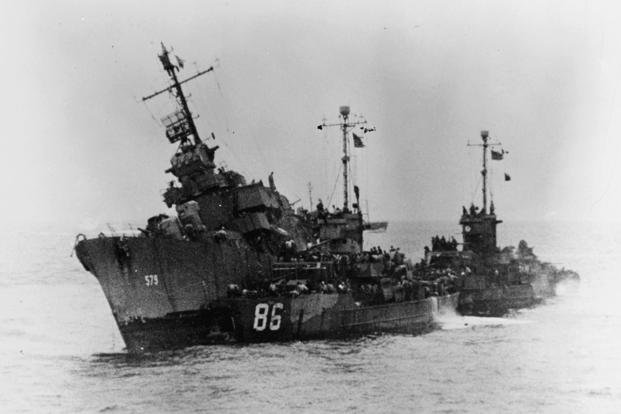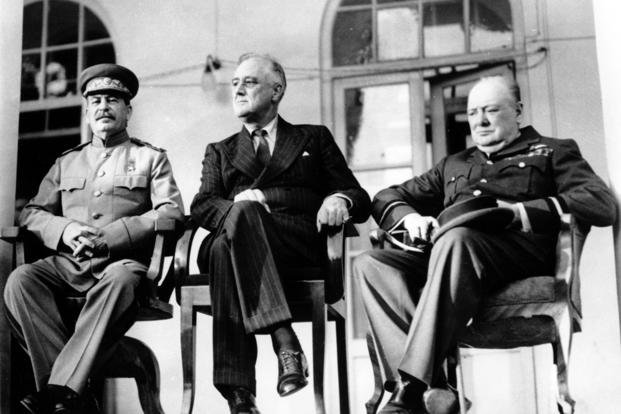A year and a half before President Franklin D. Roosevelt died of a cerebral hemorrhage in Warm Springs, Georgia, his life was put in peril on Nov. 14, 1943, all because of a torpedo inadvertently launched from a U.S. Navy destroyer during World War II.
Not long after it was commissioned, the USS William D. Porter -- named after a Union naval officer during the Civil War -- was assigned to a four-ship fleet that would transport FDR to a historic meeting with British Prime Minister Winston Churchil and Soviet Premier Joseph Stalin at the Tehran Conference. With the Porter serving as an escort destroyer on the two-week voyage, FDR, the Joint Chiefs of Staff and Secretary of State Cordell Hull would travel aboard the legendary USS Iowa (“the Battleship of Presidents”).
The high-stakes assignment came with great responsibility, and with Lt. Cmdr. Wilfred A. Walter in charge of an especially inexperienced crew, the Porter -- nicknamed the Willie Dee - - committed its first (but not last) mistake before the trip had really begun. As it was leaving the harbor in Norfolk, Virginia, on Nov. 12, the Fletcher-class destroyer’s anchor contacted another ship and inflicted significant damage. The Willie Dee emerged unscathed, though.
That incident registered as a mere footnote to what followed, harmless in comparison to when a depth charge inadvertently fell off the Willie Dee and detonated in the ocean. In a rare bit of good luck, the ship’s crew sustained no casualties, but shortly after, a large wave swept a sailor to his death.
How much FDR was made aware of what was going on with the Willie Dee can't be known with certainty, but it was probably very little. Because of the risks baked into transporting any senior government official, security measures were implemented for the highly secretive mission, including the requirement that the fleet use signal lights instead of radios to communicate.
During its various mishaps, the Willie Dee had already broken that order. It did so again after FDR, assistant secretary of the Navy under President Woodrow Wilson during World War I, requested a demonstration of the Iowa's anti-aircraft capabilities.

The Iowa started with gunners on deck shooting down balloons before moving on to a simulated torpedo attack. During such an exercise, a torpedo's primer is supposed to be removed so that it does not exit the tube and become live. Six thousand yards from the Iowa, the Porter followed proper procedure the first two times it mock-launched a torpedo.
The third time, however, the primer was still in the torpedo and shot through the water. According to author Kermit Bonner's 1996 book, "Final Voyages," when a lieutenant asked Walter whether he approved releasing a torpedo, the commanding officer stammered, "Hell, no. I, I, iii, aaa, IIIII, whatttttt?"
Chaos flooded every inch of the Willie Dee, with sailors scrambling frenetically amid the confusion and inadvertently relaying wrong information to the Iowa in an attempt to alert it of impending danger. Finally, a crew member got on the radio and urgently said, "Lion, Lion, come right." (Lion was the Iowa's code name.)
Showing no outward signs of concern, Roosevelt actually asked to have his wheelchair moved to where he could see the torpedo. A Secret Service man aimed his pistol at the missile, while the Iowa's crew -- unsure whether the act was intentional -- directed its guns at the Willie Dee. The torpedo exploded harmlessly 3,000 yards in the Iowa's wake.
After the Willie Dee docked, Marines arrested Walter and his entire crew. Several days of testimony before a board of inquiry followed before Torpedoman Lawton Dawson admitted he lied in his initial statements and claimed responsibility for leaving the primer in place. Sentenced to 14 years of hard labor, Dawson avoided serving time only after FDR ordered no crew member be punished because it was an accident.

While FDR made it safely to the Tehran Conference on Nov. 28, 1943, the Porter was transferred to the Pacific for the remainder of WWII. No matter the distance, it could not escape the stain of committing such an embarrassing error, though, with other ships greeting it with a familiar refrain: "Don't shoot, we're Republicans."
"Once you've fired a torpedo at Roosevelt, then everyone is looking at you and you get noticed for all the little things that everyone else is doing, too," sailor Bill Glover, who joined the Porter's crew in 1944, said in a 2005 World War II magazine article. "There were a lot of rookies in the service in 1943. Mistakes were made because 17-year-olds don't know how not to make mistakes."
The notorious Willie Dee sank on June 10, 1945, after a kamikaze plane missed the destroyer but exploded directly underneath it. All crew members survived.
Want to Know More About the Military?
Be sure to get the latest news about the U.S. military, as well as critical info about how to join and all the benefits of service. Subscribe to Military.com and receive customized updates delivered straight to your inbox.
















